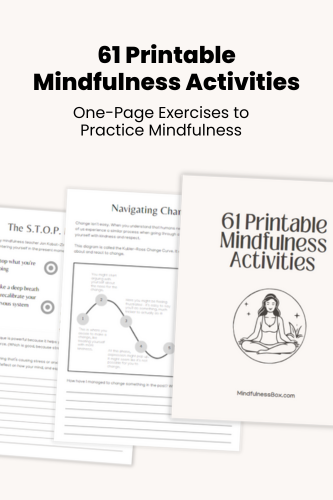A mindfulness journal template is one way to get started with mindfulness journaling quickly. Mindfulness can have profound effects on your life, but its effects aren’t immediate. That means that keeping your practice going will be one of your biggest challenges. For many people, a template for journaling can help.
If you’ve ever felt like you’re not sure you’re making progress in your mindfulness practice, you’re not alone. It takes time for mindfulness to kick in.
And even after mindfulness has started to change your brain and way of thinking, those changes may be imperceptible at first. It may be only looking back that you realize how much you’ve changed.
Get dozens of one-page exercises to help practice mindfulness, meditation, gratitude, and self love. Perfect for printable handouts when teaching mindfulness to groups, students, or in the workplace.
To see examples, plus a full list of the 61 exercises included, click below.
That’s why mindfulness journaling can be helpful. It’s one of the simplest ways to track your progress over time, observe changes in how you feel and how you deal with challenging situations, and find ways to improve your experience.
In this article, we’ll dive into the benefits of a mindfulness journal and some prompts to help you journal quicker.
The 7-Day printable Mindfulness Journal is designed to be a companion for a week of mindfulness. It includes daily prompts and reflections intended to help you reduce stress and cultivate calm in your life.
31 Days to Mindfulness is a set of printable journals, challenges, and affirmation cards designed to help you build a mindfulness habit over the course of one month.
Learn more below:
The purpose of a mindfulness journal

The purpose of a mindfulness journal is to allow you to notice how you’re feeling, and make those feelings concrete by writing them down nonjudgmentally.
Writing thoughts down on the page has a way of making them easier to deal with. For example, you might find it’s easier to combat negative ways of thinking, or understand where you need self-compassion or how you want to show up in the world.
Here are a few benefits a mindfulness journal can bring to your practice:
- It makes your progress tangible: You can flip back to earlier entries to notice how far you’ve come over time.
- It reminds you of past successes: When you’re having a tough day, you can look at how you dealt with similar situations in the past. Seeing what the “you of the past” did can be encouraging, and gives you confidence that you can handle the situation again.
- It makes emotions easier to deal with by making them concrete: Thoughts can be hard to deal with when they’re circling around in your head. Getting them down on the page can make them more manageable.
- You can set intentions: With a mindfulness journal, it’s easier to be proactive rather than reactive. Rather than walk into the week without an intention, you can think ahead to how you want to show up for the various responsibilities and activities you have planned. If you have something challenging in the coming day or week, you can decide what kind of energy you want to bring into that interaction.
- You can understand what you need, and create space for it: Without intervention, it’s easy for your calendar to fill up without any space for you. A mindfulness journal or mindfulness weekly planner gives you the chance to notice when your schedule’s too busy, and scale back on your commitments. Or, if you have no way to scale back, it allows you to at least notice that you need to show compassion for yourself as you handle the heavy workload of the day or week to come.
How do you write in a mindfulness journal?
To write in a mindfulness journal, get started by finding a blank piece of paper or a journal, or opening a note on your smartphone.
There are a couple of approaches you can take:
- Mindfulness Journal / Planner: With a mindfulness journal / mindfulness planner approach, you allow yourself to be a bit more proactive by noticing what’s coming ahead in your week or day. You decide what energy you want to bring. Even with this approach, it’s also important to check in with yourself and notice how you’re feeling in the moment, so you can be aware of your emotional state as you go into the day.
We take a Mindfulness Planner/Journal approach with the template at the bottom of this article. - Mindfulness Journal: A mindfulness journal is more about reflection. It gives you a chance to go deeper, understand why you felt a certain way or took a certain action, and consider what you might do if that situation arises again. Mindful journal templates also give you a chance to consider what you’re grateful for, in what ways you need to be compassionate for yourself, and how you can be more present in the world.
How long should a mindfulness journal entry be?
There’s no right or wrong answer here. A mindfulness journal can be as short or long as needed. Anywhere from a few sentences to multiple paragraphs.
When you’re first starting out, it might be helpful to keep it on the shorter side.
If journaling is a quick practice, rather than something that requires a lot of time, the habit can be easier to form.
Mindfulness journal prompts
There are all kinds of approaches for prompts to help you write in your mindfulness journal. In our mindfulness diary template, we focus on the following themes:
- Check in with yourself: How are you? What feelings do you notice?
- Self-care: How can you show yourself compassion today? What do you need today?
- Planning and Intentions: How do you intend to show up in the world today? What energy will you bring to today’s activities?
If you’re writing more of a reflective mindfulness journal, you can focus on questions like these:
- What’s making me feel anxious or stressed right now?
- Is there anything that I’d like to do differently in my life?
- How can I feel more aligned in life, between my thoughts and actions?
- Is there any part of myself that I’m holding back in the way I show up in the world?
- When do I feel most authentically “me”?
- Is there anything in my life that I’m struggling to accept?
- When do I most often notice falling into negative thought patterns?
You can find a list of dozens more mindfulness journal prompts here.
Get started with a printable mindfulness journal template
Ready to get started?
Studies differ on this, but if you can write for at least three weeks, you’ll increase your chances of building journaling into a long-term habit.
If you’ve read this far, you’ve got no excuse!
Here’s to building a mindfulness practice that can last for the long haul.
You’ve got this!
The 7-Day printable Mindfulness Journal is designed to be a companion for a week of mindfulness. It includes daily prompts and reflections intended to help you reduce stress and cultivate calm in your life.
31 Days to Mindfulness is a set of printable journals, challenges, and affirmation cards designed to help you build a mindfulness habit over the course of one month.
Learn more below:

My mindfulness practice kicked off in 2016 with a ten-day silent retreat. Since then, I’ve read dozens of books about mindfulness and completed hundreds of hours of meditation. Thinking about what makes humans happy, calm, and peaceful is endlessly fascinating to me.



